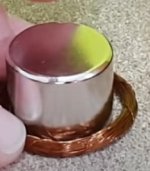Coils are necessary in electronics thus the motion is initially pistonic (or axial) by nature what happens next is complex. Of course at low frequencies the pistonic action is obvious but at higher frequencies the axial motion of the coil is still what introduces vibration to the cone. The cone offers a near infinite number of concentric circles but I suppose a diaphragm does also. Some modern speakers are diaphragms I have never seen or listened listened to one. Is there any noticeable difference in sound? They have a surround and are agitated by axial movement of the coil.
Another thought, a guitar string vibration is complex but the electronic pickup sees only the variation in distance from the pole piece.
Another thought, a guitar string vibration is complex but the electronic pickup sees only the variation in distance from the pole piece.
^^
Still, there's no pistonic action.
The coil, becomes an electromagnet when the sound source, electricity moves through it. Once, the permanent magnet brought near it, the coil wants to move, jump around, but still can't as its pasted to the table top. But, the music would go through the table top.
If you hold the coil in the air, without any surface on it, still bring the magnet to it, music would sound. You bring it near it, its enough to give out music. It is not always pistonic action that makes sound/music. (Image attached)
I wonder how Takeshi Teragaki had made the bent piece of paper sing. (video in #94)
Still, there's no pistonic action.
The coil, becomes an electromagnet when the sound source, electricity moves through it. Once, the permanent magnet brought near it, the coil wants to move, jump around, but still can't as its pasted to the table top. But, the music would go through the table top.
If you hold the coil in the air, without any surface on it, still bring the magnet to it, music would sound. You bring it near it, its enough to give out music. It is not always pistonic action that makes sound/music. (Image attached)
I wonder how Takeshi Teragaki had made the bent piece of paper sing. (video in #94)
Attachments
▲ ▲
Motion is still in the Z axis. As both the coil and the magnet are on the table with no signal their weight pushes on the table and the table pushes back. With signal the same principle of physics applies and results in vibration, action and reaction. In the table the vibration has room to spread. Have you ever watched a mechanic use a stick to find out which engine valve is clicking?
Motion is still in the Z axis. As both the coil and the magnet are on the table with no signal their weight pushes on the table and the table pushes back. With signal the same principle of physics applies and results in vibration, action and reaction. In the table the vibration has room to spread. Have you ever watched a mechanic use a stick to find out which engine valve is clicking?
^^
Vibration makes sound, not pistonic motion. The coil makes the sound. It vibrates. The pistonic motion was found later in a thin air chamber to make the attached membrane to vibrate with it, to amplify the sound. Thus came the known cone speaker. The "moving coil" was found some 120 years ago, but to put the coil into a thin air chamber and suspend it was found ~ 66 years ago. Anyway, it is the vibrations that makes sound, the pistonic motion of the electromagnetic coil is just one of them.
Its about 360 degrees of sound, after all.
Vibration makes sound, not pistonic motion. The coil makes the sound. It vibrates. The pistonic motion was found later in a thin air chamber to make the attached membrane to vibrate with it, to amplify the sound. Thus came the known cone speaker. The "moving coil" was found some 120 years ago, but to put the coil into a thin air chamber and suspend it was found ~ 66 years ago. Anyway, it is the vibrations that makes sound, the pistonic motion of the electromagnetic coil is just one of them.
Its about 360 degrees of sound, after all.
yeah yeah, writing dml I meant bending wave, BTW not much discussion there
...so ...basically it behaves "like a point source"? which is where? Is it constantly moving within the panel? This would explain why it sounds hazy or muffled
one way or another a point source at some height and distance in front of the listener is NOT the best solution for sound reproduction in a real room
Its about 360 degrees of sound, after all.
360° just like tossing a pebble into a lake, just physics after all.
Back to topic.
When placing speakers up-firing, at the ear height or slightly above it, we can eliminate to a large degree, the deflection of sound from the floor. Placing the speakers flush to the wall, makes the wall part of the source of sound. Placing the bass-reflex vent nearer the wall, than the woofer, makes the bass more realistic. If there are no wall furniture, it'd be an advantage, and if the walls (and ceiling) are solid, not hollow timer frame construction.
One has to try this to find out.
When placing speakers up-firing, at the ear height or slightly above it, we can eliminate to a large degree, the deflection of sound from the floor. Placing the speakers flush to the wall, makes the wall part of the source of sound. Placing the bass-reflex vent nearer the wall, than the woofer, makes the bass more realistic. If there are no wall furniture, it'd be an advantage, and if the walls (and ceiling) are solid, not hollow timer frame construction.
One has to try this to find out.
at the ear height or slightly above
rather close to the floor
example:
An externally hosted image should be here but it was not working when we last tested it.
How is your ability to hear high frequencies?
Excellent!
By the way, my wife has even better hearing, and also music school background. Her brother is a tuner of pianos, also a music teacher, so no problem of testers.
rather close to the floor
example:
That speaker is not up-firing. That guy sits so near, most probably his knees hear better.
that's Stig Carlsson, and a publicity photo
They all went out of business in time.
- Status
- This old topic is closed. If you want to reopen this topic, contact a moderator using the "Report Post" button.
- Home
- Loudspeakers
- Multi-Way
- How you hear your speakers, are they omnidirectional?

